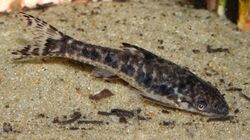Biology:Otocinclus
| Otocinclus | |
|---|---|

| |
| Otocinclus arnoldi | |
| Scientific classification | |
| Domain: | Eukaryota |
| Kingdom: | Animalia |
| Phylum: | Chordata |
| Class: | Actinopterygii |
| Order: | Siluriformes |
| Family: | Loricariidae |
| Tribe: | Hypoptopomatini |
| Genus: | Otocinclus Cope, 1871 |
| Type species | |
| Otocinclus vestitus Cope, 1872
| |
Otocinclus is a genus of catfish in the family Loricariidae native to South America, commonly known as "dwarf suckers" or "otos". This genus, like other loricariids, is characterized by rows of armour plating covering the body, as well as the underslung suckermouth. They are generally small in size; O. tapirape is the smallest of the species (2.4 cm), while O. flexilis is the biggest (5.5 cm).[1] These species have adaptations that allow them to breathe air. A duct forms at the junction between the esophagus and the stomach and expands into an enlarged, ring-like diverticulum, characteristic of this genus, which allows air-breathing.[2] Otocinclus are popular aquarium fish, and they are often purchased as algae eaters. It is difficult to breed them in captivity, and only wild caught Otocinclus are available to hobbyists. This genus is widely distributed east of the Andes of South America, throughout the lowlands from northern Venezuela to northern Argentina , but are generally absent from the Amazon and the Orinoco lowlands.[3]
Etymology
The Otocinclus name is derived from the Greek oto, meaning ear and the Latin cinclus, meaning a latticework, an allusion to the holes in the head in the region of the ear.[1]
Taxonomy
Otocinclus is the most basal genus of the tribe Hypoptopomatini of the subfamily Hypoptopomatinae. However, phylogenetic relationships are currently under study and this genus may eventually be relocated.[4] Its monophyly is supported by seven derived features. O. batmani, O. bororo, O cocama, O. huaorani, O. mariae and O. mura form a monophyletic group within this genus.[4] A monophyletic group is also formed by O. flexilis, O. mimulus and O. xakriaba, which all share mimicry as a synapomorphy.[3]
Species
There are currently 19 recognized species in this genus:
- Otocinclus arnoldi Regan, 1909
- Otocinclus batmani Lehmann A., 2006[4]
- Otocinclus bororo Schaefer, 1997
- Otocinclus caxarari Schaefer, 1997
- Otocinclus cocama R. E. dos Reis, 2004
- Otocinclus flexilis Cope, 1894
- Otocinclus hasemani Steindachner, 1915
- Otocinclus hoppei A. Miranda-Ribeiro, 1939
- Otocinclus huaorani Schaefer, 1997
- Otocinclus juruenae A. C. Ribeiro & Lehmann A., 2016[5]
- Otocinclus macrospilus C. H. Eigenmann & W. R. Allen, 1942
- Otocinclus mangaba Lehmann A., Mayer & R. E. dos Reis, 2010[6]
- Otocinclus mariae Fowler, 1940
- Otocinclus mimulus Axenrot & S. O. Kullander, 2003
- Otocinclus mura Schaefer, 1997
- Otocinclus tapirape M. R. Britto & C. L. R. Moreira, 2002
- Otocinclus vestitus Cope, 1872
- Otocinclus vittatus Regan, 1904
- Otocinclus xakriaba Schaefer, 1997
Macrotocinclus affinus was considered to be a member of Otocinclus until it was moved to its own monotypic genus, Macrotocinclus.[7] The name Otocinclus affinus is still used in the aquarium trade, however it actually refers to members of O. vittatus, O. vestitus and O. macrospilus. and O. huaorani.
Ecology
Species of this genus are diurnal and generally are found in small streams or along the margins of larger rivers, clinging to substrates using their suckermouth. The fish of this genus primarily feed on algae or aufwuchs on roots, stones, macrophytes and broad-leaved grasses.[3] They inhabit well-oxygenated, moderate- to slow-flowing environments, often near river banks. They are found near the surface of the water, but are often associated with vegetation or other structures.[4] They lay adhesive eggs and do not guard them; this is in contrast to many other loricariids where the male builds a nest and guards the eggs.[8] These fish live in shoals or schools.[3] Otocinclus are able to breathe air. Prior to surfacing, they will release air through their gills and mouth. Upon returning to the bottom, the fish do not need to pump their buccal cavities, indicating they are absorbing oxygen from the swallowed air.[2]
O. flexilis, O. mimulus and O. xakriaba are considered to be Batesian mimics of certain Corydoras species (C. diphyes, C. garbei, C. nattereri and C. paleatus, respectively). These Corydoras species have bony plates of armor and strong spines as defenses, making them less palatable; by mimicking these species in size and coloration, Otocinclus spp. avoid predation.[3]
References
- ↑ 1.0 1.1 Froese, Rainer and Pauly, Daniel, eds. (2016). Species of Otocinclus in FishBase. June 2016 version.
- ↑ 2.0 2.1 Armbruster, J.W. (1998): Modifications of the Digestive Tract for Holding Air in Loricariid and Scoloplacid Catfishes. Copeia, 1998 (3): 663–675.
- ↑ 3.0 3.1 3.2 3.3 3.4 Axenrot, T.E. & Kullander, S.O. (2003): Corydoras diphyes (Siluriformes: Callichthyidae) and Otocinclus mimulus (Siluriformes: Loricariidae), two new species of catfishes from Paraguay, a case of mimetic association. Ichthyological Exploration of Freshwaters, 14 (3): 249–272.
- ↑ 4.0 4.1 4.2 4.3 Lehmann, A., P. (2006): Otocinclus batmani, a new species of hypoptopomatine catfish (Siluriformes: Loricariidae) from Colombia and Peru. Neotropical Ichthyology, 4 (4): 379–383.
- ↑ Ribeiro, A.C. & Lehmann, A., P. (2016): A new Otocinclus (Siluriformes: Loricariidae: Hypoptopomatinae) from the Rio Juruena Basin, central Brazil. Zootaxa, 4147 (3): 240–246.
- ↑ Lehmann, A., P., Mayer, F. & Reis, R.E. (2010): A New Species of Otocinclus (Siluriformes: Loricariidae) from the Rio Madeira Drainage, Brazil. Copeia, 2010 (4): 635–639.
- ↑ Macrotocinclus Isbrücker & Seidel, 2001 in GBIF Secretariat (2019). GBIF Backbone Taxonomy. Checklist dataset doi:10.15468/39omei accessed via GBIF.org on 2020-12-16.
- ↑ Fenner, R.. "The Ideal Algae Eater? The Littlest South American Suckermouth Catfishes, Genus Otocinclus". http://www.wetwebmedia.com/FWSubWebIndex/otocinclusart.htm.
Wikidata ☰ Q1141986 entry
 |

